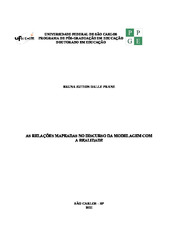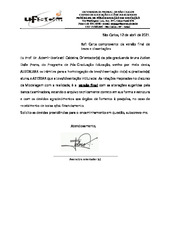| dc.contributor.author | Prane, Bruna Zution Dalle | |
| dc.date.accessioned | 2021-04-16T12:14:25Z | |
| dc.date.available | 2021-04-16T12:14:25Z | |
| dc.date.issued | 2021-03-05 | |
| dc.identifier.citation | PRANE, Bruna Zution Dalle. As relações mapeadas no discurso da modelagem com a realidade. 2021. Tese (Doutorado em Educação) – Universidade Federal de São Carlos, São Carlos, 2021. Disponível em: https://repositorio.ufscar.br/handle/ufscar/14121. | * |
| dc.identifier.uri | https://repositorio.ufscar.br/handle/ufscar/14121 | |
| dc.description.abstract | This research aims to problematize the composition operated by the Mathematical Modeling discourse about reality within the scope of published researches concerning Mathematical Modeling. In this work, Mathematical Modeling is conceived as a discourse, using as a theoretical-methodological basis the theories of the philosopher Michel Foucault and his commentators. The research was constituted, at first, called trail 1, by the congress proceedings of the National Conference on Mathematical Modeling and the International Research Seminar in Mathematical Education, both in the period from 2003 to 2018 and, later, called trail 2, by fifteen works published that discuss, exclusively, the relationship between Modeling and reality. Through the analysis of the congress proceedings, it was possible to map the following statements: Modeling, through mathematical models, represents reality; Modeling, through the mathematical language, allows the student to understand reality and Modeling, through the mathematical language, allows the student to understand, intervene and transform the reality that surrounds him. The statements show different behaviors regarding reality, however, they all build the same composition on the real, that is, the one to be modeled by the curricular mathematical contents, which produce ways of acting and thinking about the subjects and reverberating ideals of Modernity. In the second moment, when analyzing works involving Modeling and reality, the approximation with the philosophical discourses: Classic, Modern and Contemporary was mapped in the construction of this relationship. Through these analyzes it is possible to affirm that the relationship between Modeling and the reality close to the Classic philosophical discourse builds the vision of a reality that has an essence; in Modern philosophical discourse, he conceives the view that reality will be elaborated with the subject; and in Contemporary philosophical discourse, reality is constructed based on language. The analyzes made suggest that the construction of the reality operated by the Modeling discourse can be seen as a resource to continue operating the teaching of Mathematics based on the vision of knowledge as a reliable representative of reality. | eng |
| dc.description.sponsorship | Não recebi financiamento | por |
| dc.language.iso | por | por |
| dc.publisher | Universidade Federal de São Carlos | por |
| dc.rights | Attribution-NonCommercial-NoDerivs 3.0 Brazil | * |
| dc.rights.uri | http://creativecommons.org/licenses/by-nc-nd/3.0/br/ | * |
| dc.subject | Modelagem matemática | por |
| dc.subject | Realidade | por |
| dc.subject | Enunciado | por |
| dc.subject | Discurso | por |
| dc.subject | Sujeito | por |
| dc.subject | Mathematical modeling | eng |
| dc.subject | Reality | eng |
| dc.subject | Statement | eng |
| dc.subject | Discourse | eng |
| dc.subject | Subject | eng |
| dc.title | As relações mapeadas no discurso da modelagem com a realidade | por |
| dc.title.alternative | The mapped relationships in modeling's discourse with reality | eng |
| dc.type | Tese | por |
| dc.contributor.advisor1 | Caldeira, Ademir Donizeti | |
| dc.contributor.advisor1Lattes | http://lattes.cnpq.br/8185048034258055 | por |
| dc.description.resumo | Esta pesquisa tem por objetivo problematizar a composição operada pelo discurso da Modelagem Matemática sobre a realidade no âmbito de pesquisas publicadas referentes à Modelagem Matemática. Neste trabalho, concebe-se a Modelagem Matemática como discurso, utilizando como base teórico-metodológica as teorizações do filósofo Michel Foucault e de seus comentadores. A pesquisa foi constituída, em um primeiro momento, denominado trilha 1, pelos anais da Conferência Nacional sobre Modelagem Matemática e do Seminário Internacional de Pesquisa em Educação Matemática, ambos no período de 2003 a 2018 e, posteriormente, denominado trilha 2, por quinze trabalhos publicados que discutem, exclusivamente, a relação entre Modelagem e realidade. Por meio das análises dos anais foi possível mapear os seguintes enunciados: a Modelagem, por meio de modelos matemáticos, representa a realidade; a Modelagem, por meio da linguagem matemática, possibilita ao estudante compreender a realidade e a Modelagem, por meio da linguagem matemática, possibilita ao estudante compreender, intervir e transformar a realidade que o rodeia. Os enunciados evidenciam condutas diferentes a respeito da realidade, entretanto, todos constroem uma mesma composição sobre o real, isto é, aquele a ser modelado pelos conteúdos matemáticos curriculares, que produzem modos de agir e pensar nos sujeitos e reverberam ideais da Modernidade. No segundo momento, ao analisar trabalhos envolvendo a Modelagem e a realidade, mapeou-se a aproximação com os discursos filosóficos: Clássico, Moderno e Contemporâneo na construção dessa relação. Por meio dessas análises é possível afirmar que a relação entre a Modelagem e a realidade próxima ao discurso filosófico Clássico constrói a visão de uma realidade que tem uma essência; no discurso filosófico Moderno, concebe a visão de que a realidade será elaborada com o sujeito; e no discurso filosófico Contemporâneo, a realidade é construída baseada na linguagem. As análises feitas sugerem que a construção da realidade operada pelo discurso da Modelagem pode ser vista como um recurso para continuar operando o ensino de Matemática pautado na visão do conhecimento como representante fidedigno da realidade. | por |
| dc.publisher.initials | UFSCar | por |
| dc.publisher.program | Programa de Pós-Graduação em Educação - PPGE | por |
| dc.subject.cnpq | CIENCIAS HUMANAS::EDUCACAO | por |
| dc.publisher.address | Câmpus São Carlos | por |
| dc.contributor.authorlattes | http://lattes.cnpq.br/4707006822711579 | por |


